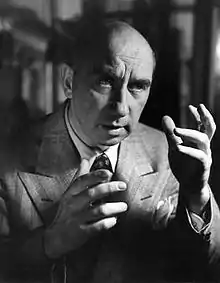John Brahm
John Brahm (August 17, 1893 – October 12, 1982) was a German film and television director.[1] His films include The Undying Monster (1942), The Lodger (1944), Hangover Square (1945), The Locket (1946), The Brasher Doubloon (1947), and the 3D horror film, The Mad Magician (1954).
John Brahm | |
|---|---|
 | |
| Born | Hans Brahm August 17, 1893 Hamburg, German Empire |
| Died | October 12, 1982 (aged 89) Malibu, California, U.S. |
| Occupation | Film director, television director |
Early life
Brahm was born Hans Brahm in Hamburg, the son of actor Ludwig Brahm and his wife. His family was involved in theater; his paternal uncle was theatrical impresario Otto Brahm.[2]
Career
Brahm started his career in the theatre as an actor. After World War I, he traveled and worked among the cities of Vienna, Berlin and Paris, which had the most artistic cultures of the time. He eventually became a director, and was appointed as resident director for acting troupes at the Deutsches Theater and the Lessing Theater, both in Berlin.[2]
With the rise of Adolf Hitler and the Nazi Party in Germany in the 1930s, Brahm left the country, first moving to England. After working as a movie production supervisor, he got a chance to direct his first film Broken Blossoms in 1936. It was a remake of the American director D.W. Griffith's 1919 film by the same name.
In 1937, Brahm moved to the US, where he began his Hollywood career at Columbia Pictures. He joined an increasing number of European emigres working in the American film studios in this period. Eventually he moved to 20th Century-Fox. He directed the ill-fated Let Us Live, the true story of two men wrongly convicted of murder who were almost executed by the Commonwealth of Massachusetts. State authorities were embarrassed by this fiasco and put pressure on the studio to cancel the film. The studio completed the film, but kept it to a small budget.
In his book, The American Cinema: Directors and Directions 1929–1968, American film historian and critic Andrew Sarris states that Brahm "hit his stride" in the 1930s with "mood-drenched melodramas." He suggested that Brahm's work declined after this period. Sarris said that Brahm did not lack work, as he made "approximately 150 TV films"[3] during the 1950s and 1960s. Among these, he also directed numerous episodes of Alfred Hitchcock Presents and The Twilight Zone. Brahm's last full-length film was Hot Rods to Hell.[4]
Personal life
He married an actress named Hanna, who ran off with another actor, leaving him seriously depressed. Secondly, he married actress Dolly Haas. They divorced after coming to the United States, when their careers moved in different directions.[2] She appeared in New York theatre and in 1943 she married again, to Al Hirschfeld, the caricaturist for the New York Times.
In the 1950s Brahm married his third wife, Anna. They had two children together. Their grandchildren include Christopher Maltauro, who became a movie producer and assistant director.
Selected filmography
|
|
References
- Profile, The New York Times; accessed October 31, 2014.
- John Brahm at AllMovie
- Sarris, Andrew (1968). The American cinema; directors and directions, 1929–1968. New York: Da Capo Press. p. 253. ISBN 978-0-306-80728-2.
- Mank, Gregory William (2001). Hollywood Cauldron: Thirteen Horror Films From the Genre's Golden Age. Jefferson, N.C.: McFarland & Co Inc Pub. p. 350. ISBN 978-0-7864-1112-2.
External links
- John Brahm at IMDb
- Tribute site, sumishta.com; accessed A tribute to John Brahm created by his daughter Sumishta Brahm; accessed October 31, 2014.